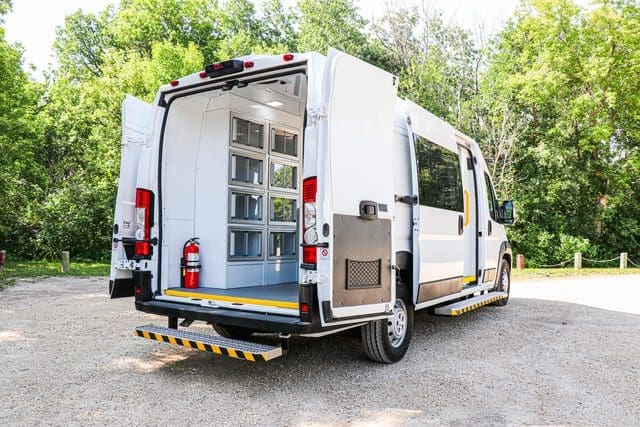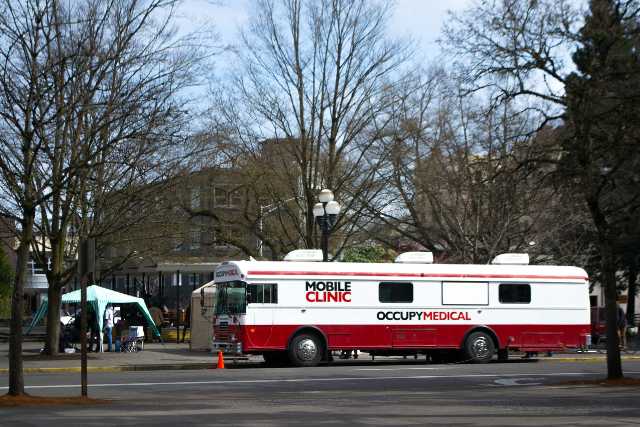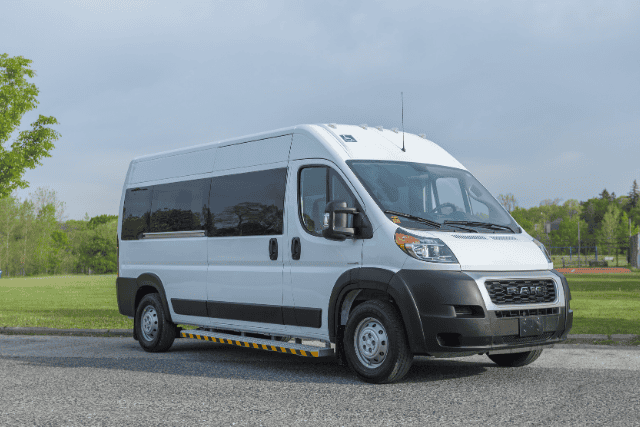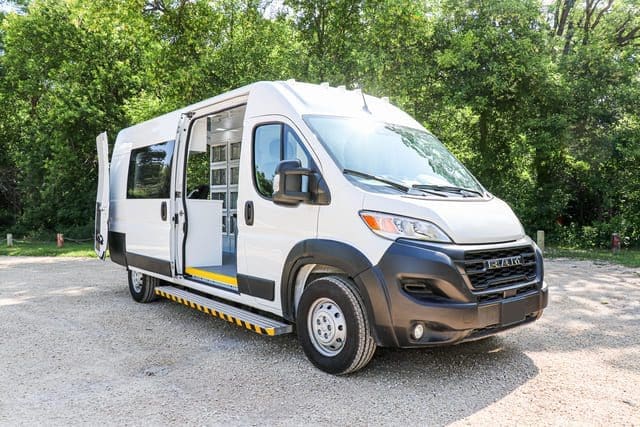Deciding on the best mobile medical vehicle for your organization can be tough. You might be looking to reach remote areas of the U.S. to provide healthcare, or you want to help people right in your city. With so many choices out there, it’s normal to feel a little unsure about picking a mobile medical bus. We understand that and are here to help you figure it out.
Here at AVAN Mobility, we’ve been manufacturing mobile medical units for over 10 years. We know what it takes to create vehicles that fit the unique needs of organizations like yours. Our vehicles are engineered to conquer many accessibility obstacles, including rural and remote landscapes or bustling urban environments.
In this article, we’ll look at the pros and cons of choosing a mobile medical bus. We want to give you a clear picture to help you decide wisely. Knowing the pros and cons is important because it helps you understand what to expect, make the best choice for your organization’s needs, and plan for any challenges. Let’s get started and see if a mobile medical bus is the right pick for your organization.
Pros of a mobile medical bus
Mobile medical buses have a few advantages that may be attractive for some organizations.
1. Lots of space
One of the good things about a mobile medical bus is that it has a lot of space.
Space for equipment: There’s plenty of room to fit all kinds of medical equipment. This means the bus can be set up for different health needs, from check-ups to urgent care.
Help more people at once: With more room, more people can get help at the same time. This is useful in places where it’s hard to find a doctor.
Flexible setup: Due to the large size of a mobile medical bus, you have a lot of flexibility in arranging the interior in different ways depending on what you need. This makes it easy to change things around as your requirements change. For example, you can turn the entrance into a waiting area while serving patients in another part of the bus.
2. Many healthcare options
The mobile medical bus can be used as a one-stop shop for healthcare. Your organization can use it to provide a wide range of medical services to communities all over the U.S.
All-in-one healthcare: Imagine a patient coming in to get their flu shot, having their teeth checked, and learning about nutrition all in one visit. That’s what your organization can do with a mobile bus offers—a variety of health services in one spot.
Special care, no extra travel: Even if local clinics in remote communities don’t have certain equipment, the bus can bring it to their neighborhood. This means they can get specialized care without having to travel long distances.
Learn while you wait: A mobile medical bus doesn’t have to only be used for check-ups; it can also be a place to learn about staying healthy. Your organization can use it to give tips and advice to patients on how to look after their health.
The combination of these factors makes the mobile medical bus an effective tool for bringing a wide range of medical services and education directly to communities, making healthcare simple and accessible for everyone.
3. Ideal for long-term medical assistance
Mobile medical buses are suitable for setting up long-term health services, especially when a big emergency arises, and local hospitals are too full or possibly even damaged. Because buses are so big, they can be turned into temporary hospitals that can stay in one place for a long time.
Mobile medical buses can provide:
Continuous care: If a natural disaster happens and hospitals can’t handle more people, these buses can be set up to help immediately. They can stay as long as needed, offering care day after day.
Adaptable for different needs: Your bus’s medical services can change based on what people need most. For example, if you’re in an area that was just hit by a natural disaster, you might start off as a place to treat injuries. Once you’ve treated all the injuries, you might switch to giving out shots or doing health checks.
Cons of a mobile medical bus

Now that you know about some of the advantages of mobile medical buses, let’s take a look at some of the disadvantages.
1. Navigational challenges due to size
Even though it’s great to have a lot of room in a mobile medical bus, its big size can make it hard to drive and park. Here’s what makes driving a big bus a bit of a challenge:
Rural navigation: Think about trying to drive a big bus on a narrow country road that twists and turns around sharp corners. It takes a lot of skill and demands more attention on the road.
This can become frustrating over time, especially when trying to deliver healthcare services to remote regions. The size of a bus could limit your access to these remote communities where healthcare is most needed.
City navigation: In busy urban areas, the sheer size of a medical bus can be a drawback. Crowded streets and tight parking spaces make it tough to find suitable locations to park and operate. This could potentially reduce the effectiveness of outreach in densely populated regions.
Delays: When you’re driving a large mobile medical bus, getting to where you need to be can take longer, especially if the roads are small or packed with traffic. This can be a problem when you need to be on time, like for emergency assistance or health check-ups.
2. Mobile medical buses require a steep budget
Switching to mobile healthcare is a big decision, especially when it comes to the budget. If you’re looking for a mobile medical bus, here’s the scoop: they can be pretty pricey upfront.
Initial price tag: Because mobile medical buses are like rolling hospitals, that also means they’re not cheap to set up. This hefty cost might be a bit too steep for small businesses or startups.
Operational costs: Mobile medical buses also have higher ongoing operational costs than their smaller counterparts. The complex system and larger size of buses lead to higher maintenance, insurance, and fuel costs.
Costs are a big deal, and it’s wise to consider what makes sense for your business right now and what you might need as you grow. Buses have their perks, but we can’t sugarcoat that they come with a higher price tag, often between $300,000 and $800,000+.
3. Mobile medical bus driver’s licensing requirements
Driving a mobile medical bus isn’t as straightforward as driving a standard vehicle—it requires a Commercial Driver’s License (CDL). Here’s a look at what that entails and why it matters:
CDL overview: A CDL is required for large vehicles, including buses because these vehicles have unique handling characteristics and safety considerations. The license ensures drivers are trained to manage larger dimensions and different driving dynamics.
Training: To get a CDL, prospective drivers must complete a training program that includes both classroom instruction and practical driving experience. The curriculum covers a wide range of topics, from vehicle maintenance to advanced on-road driving techniques and safety regulations.
Examination: After training, drivers must pass a series of tests. These tests typically include a written exam and a driving skills test, which assess a driver’s ability to operate large vehicles safely under various conditions.
Implications for staffing: The requirement for a CDL can complicate staffing for mobile medical buses. Finding qualified drivers who already have a CDL or are willing to undergo the necessary training can be a challenge, potentially limiting your organization’s operational flexibility.
Could a mobile medical van be your solution?

Deciding on your organization’s next mobile medical vehicle can feel overwhelming, can’t it? Let’s break down why a mobile medical van might just solve a few of the headaches discussed earlier for you:
Easier navigation: Think about driving a sports car versus a big RV through narrow, bustling city lanes. Mobile medical vans are the sports cars in this analogy. Their compact size lets you slip through tight spots and crowded streets without a sweat, making every trip smoother and faster.
Budget-friendly: We know budget matters to every organization. Vans are generally less pricey upfront compared to buses. They also keep your ongoing costs down — think lower fuel expenses, cheaper maintenance, and more affordable repairs.
No special license needed: Here’s a big relief — you don’t need a special license to drive a medical van. Anyone with a regular driver’s license can operate it, simplifying staffing and cutting training costs.
Choosing a mobile medical van means picking a flexible, cost-efficient solution that can fit right into your daily operations. It’s perfect for organizations that need to zip around urban settings or touch base with patients in remote areas without the hassle of a larger vehicle. So, if you’re looking for a way to deliver healthcare with less fuss, the van could be your ideal match.
Decide on your mobile medical vehicle with confidence
You found this article while looking for more information on mobile medical buses. Now, you know more about the benefits and drawbacks of these vehicles.
At this point, if you’re looking for more information before making a decision, we encourage you to check out our article on the cost of a mobile medical van.
We also think you’ll get some value from checking out our article on mobile medical van service. This will give you some insight into what to expect if you choose a mobile medical van and want to get maintenance on it.
If you’d rather speak to a mobility expert with any other questions you might have, click the button below.





